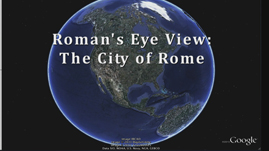Teachers' Domain - Digital Media for the Classroom and Professional Development
User: Preview



In this video, students take a virtual tour of the city of Rome, capital of the Roman empire, during the 1st century A.D. The location of Rome, situated 15 miles inland on the banks of the Tiber River, offered it protection from naval attack as well as access to the wealth of sea trade. The seven hills upon which Rome was founded offered it further protection from attack as well as flooding. The city’s extensive system of aqueducts transported water from as far as 50 miles away to many public fountains and baths. Students visit one such fountain, the Fontana di Trevi, constructed in the 18th century.
A Roman’s-Eye View: The Capital
The Tiber River, the famous Seven Hills of Rome, and the supply of fresh water nearby had a large influence on the development and persistence of that city throughout the millennia. The Tiber River, on which the city was founded, both offered a mode of easy access to the Mediterranean Sea, where goods could be shipped to other parts of the world, and also protected the city from naval attack by allowing it to rest fifteen miles inland. Still, the frequent yet sudden flooding of the Tiber caused much destruction, encouraging city leaders to plan residential and business areas away from the flooding area.
The Seven Hills of Rome—the most famous of which are the Capitoline and the Palatine—offered another kind of protection to the city. They provided a refuge from the Tiber’s flooding as well as protection from outside attack.
Finally, the abundance of fresh water in the area made it possible to support a large population. The Romans made full use of this supply by constructing aqueducts to direct water from a source at a higher elevation than the city. These aqueducts were skillfully engineered to transport water at a steady, appropriate grade from a distance of as far as 50 miles. Aqueducts generally transported water underground in order to protect it from contamination or sabotage; however, where irregularities in terrain prevented this, architects used arches to support the aqueducts at the necessary heights.
These aqueducts fed into the city’s fountains and public baths, providing fresh water for drinking, before washing down into the sewer, taking the city’s waste down with it. One such fountain is the Fontana di Trevi, constructed in the 18th century at the end of the ancient Aqua Virgo.
 Loading Standards
Loading Standards